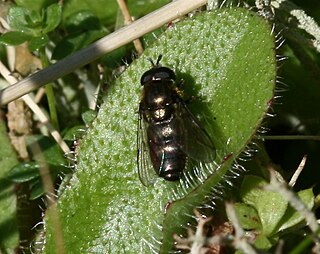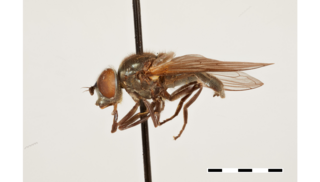
Eristalis is a large genus of hoverflies, family Syrphidae, in the order Diptera. Several species are known as drone flies because they bear a resemblance to honeybee drones.

Hover flies of the genus Microdon are unusual among the Diptera. Like other members of the subfamily, they are myrmecophiles, meaning they inhabit the nests of ants.

Xylota is a Holarctic genus of hoverflies similar in structure to the related genera Chalcosyrphus and Brachypalpoides. As the larvae are saprophytic they're usually found in rotting wood. The adult flies are generally associated with woodland and woodland edges and can often be seen running over the upper sides of leaves. Unlike other syrphids the adults of many species rarely visit flowers preferring instead to gather pollen from leaf surfaces. There are over 100 described species of which 12 can be found in Europe. Seven species have been recorded in Britain. Identification of species has been difficult and identifiction by photographs is risky.

Spilomyia is a genus of hoverflies. Many species in the genus show Batesian mimicry of wasp models, including black and yellow patterns and modified antenna shape.

Ceriana is a genus of hoverfly. All species are wasp mimics.

Cheilosia is a genus of hoverfly. Most Cheilosia are black or largely un-coloured, lacking the bright colours and patterns of many hoverfly species. It is one of the most species diverse genera of hoverflies. The biology of many species is little understood, but where known, the larvae of Cheilosia species feed in the stems of plants or in fungi.

Eumerus is a genus of hoverflies, within the tribe Eumerini.

Medetera is a large genus of flies in the family Dolichopodidae. It includes about 350 species worldwide. The adults are commonly found resting on vertical surfaces such as tree trunks, on which they have a characteristic vertical upright stance. Because of this stance, they are sometimes known as "woodpecker flies". Medetera adults are predators of soft-bodied arthropods, while the larvae are predators of bark beetle larvae.

Rhaphium is a genus of flies in the family Dolichopodidae. It is the largest genus within the subfamily Rhaphiinae, with over 200 species currently known.

Scellus is a genus of flies in the family Dolichopodidae. It is distributed in the Palearctic and Nearctic.

Syntormon is a genus of flies in the family Dolichopodidae. It includes about 110 species worldwide, more than 50 of which were described from the Palaearctic realm.

Chalcosyrphus is a genus of hoverflies in the subfamily Eristalinae. Many species exhibit some degree of mimicry of various sawflies and other hymenopterans and are often brightly coloured or metallic in hue. The adults are similar in structure and behavior to the related genus Xylota but differ in larval morphology. They can be found throughout Europe, Asia, and North America and seem to prefer damper, boggy habitats. The larvae are saproxylic feeders in rotten wood in these habitats.

Chrysogaster is a genus of small hoverflies in the subfamily Eristalinae. They are dark or black with shiny colourful reflections and can often be seen visiting flowers in damp marshy areas where the aquatic larvae live. Species in the related genera Melanogaster, Orthonevra, Lejogaster and Riponnensia were formerly treated as members of Chrysogaster.

Sphegina is a genus of small, slender hoverflies. They are widespread throughout Eurasia and North America. In flight they seem to have long hind legs which they often carry hanging down, making them resemble sphecid or ichneumonid wasps. Adult Sphegina are usually found in damp and shady habitats close to water in forested areas, and several species can often be found together. They often feed on white and yellow flowers of Apiaceae, Ranunculaceae, Asteraceae, and Rosaceae like Crataegus, Sorbus, and Sorbaria. Larvae nest in the sap of living and dead trees or in decaying cambium under tree bark lying in water or other damp conditions. The larvae of some species have been discovered in the tunnels of other xylophagous insects.

Orthonevra is a genus of fly in the syrphidae family with at least 59 species identified so far. They are worldwide in distribution but concentrated in the Eastern North America and Europe.Orthonevra are commonly called Mucksuckers after the larvae which have been found in organic rich mud, i.e. muck. This genus belongs to the tribe Brachyopini that includes the prominent genera Melanogaster, Brachyopa, Neoascia and Sphegina. Orthonevra have black heads with blue to purple reflections. Many species have distinctive eye stripes. The antennae are somewhat elongate. The frons is wrinkled with silvery spots at sides of antennae. The thorax with small punctures dorsally and in several species the body is covered with scale-like pile. Wingd vein M1 curves away from the wing tip.(see images)

Pipiza is a genus Hoverflies, from the family Syrphidae, in the order Diptera. Most are dark hoverflies.

Pipizella is a genus of Hoverflies, from the family Syrphidae, in the order Diptera.

Chrysosyrphus, the Wrinklehead flies, is a genus of hoverflies in the family Syrphidae. They are native the holarctic region. These flies are small and black., The adults feed on nectar and pollen the sources of energy and protein respectively. Larvae are unknown.
Lejota is a genus of syrphid flies in the family Syrphidae.


















